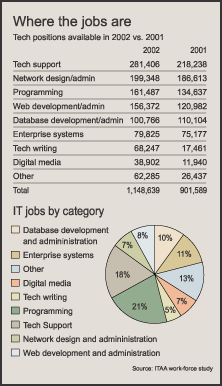Workforce glass half full and half empty

When Pat Dawson read a new information technology workforce study published this month, he noted that at least one major finding didn't apply to his company, Anteon Corp. of Fairfax, Va. Unlike many high-tech companies, Anteon wasn't laying off workers.
When Pat Dawson read a new information technology workforce study published this month, he noted that at least one major finding didn't apply to his company, Anteon Corp. of Fairfax, Va. Unlike many high-tech companies, Anteon wasn't laying off workers."We haven't had to let any tech people go," said Dawson, senior vice president for administration at Anteon. "When you are an acquiring company, often you will cut back on some overhead functions. We've been able to take those IT people supporting the [acquired] company and put them on the job."Systems integrator Anteon has expanded its staff from 1,200 to 5,400 over the last six years and increased its revenue an average 15 percent annually. Dawson said he expects that growth to continue."If you are going to grow by 15 percent, you are going to need 15 percent more people to do the work," he said. Anteon, which is firmly anchored in the federal IT marketplace, was more fortunate than other IT companies. According to a workforce study published this month by the Information Technology Association of America, U.S. companies dropped 500,000 IT workers from their payrolls last year, cutting the work force from 10.4 million in 2000 to 9.9 million in 2001. The study, "Bouncing Back: Jobs, Skills and the Continuing Demand for IT Workers," found tech workers employed by IT companies were much more likely to be laid off than workers employed by non-IT companies. IT firms cut their tech staffs by 15 percent in 2001, while non-IT companies cut their staffs just 4 percent. ITAA, a trade association in Arlington, Va., represents 500 member IT companies. ITAA's workforce study was conducted by Market Decisions Corp. of Portland, Ore. Market Decisions conducted phone interviews in March with 532 randomly selected hiring managers at IT and non-IT companies. The survey has a margin of error of 3.6 percent.The study revealed one bright spot: Hiring managers said they want to fill 1.1 million jobs in the next 12 months, up 27 percent from last year. That new demand is an indicator of economic recovery, said Harris Miller, ITAA president. "We find people are cautiously optimistic," he said.Jeff Chambers, human resources director at SAS Institute Inc., another federal IT contractor, exudes optimism about the Cary, N.C., software and IT services firm. Like Dawson, Chambers said the study doesn't entirely ring true in his workplace."I believe what [the survey] says. I just haven't seen it in our shop," Chambers said. "We are still in the hiring mode."Federal IT contractors said they do mirror one aspect of the study, which revealed considerable difficulty finding employees with the exact skills needed on the job. For the second straight year, hiring managers surveyed by ITAA said they would have trouble filling nearly one out of every two jobs because applicants' skills don't match their needs. Of the 1.1 million positions managers want to fill this year, almost 600,000 will remain unfilled because workers don't have the right skills for them, the study found."It's not difficult to find people. It's difficult to find people with the right skills," said Mike DeBruhl, senior vice president for human resources in the IT division of DynCorp in Chantilly, Va.A skills profile included in the survey ? derived from the 30,000 technical jobs listed on IT job board Dice.com ? found that the C programming language is the hottest technical skill, followed by Oracle, SQL, Java and Windows NT. But particularly in the federal marketplace, customers want more than technical skills. They also want experience in a specific area, such as finance, the environment or logistics. They also need people with security clearances, a qualification not needed for private-sector IT work."We have no problem finding people with Java or C, the hot skills of the day. But if they have to have functional experience in finance or logistics, that's where we have a problem," Dawson said.For SRA International Inc. of Fairfax, Va., the security clearance requirement is the sticky wicket, said Kerri Koss Morehart, vice president of talent acquisition and development. Nearly 85 percent of the company's work requires a clearance, which allows access to classified information, Morehart said. "We can find the people with the skills, but citizenship and clearance issues self-select people out," said Morehart, who said the clearance requirement adds three to six weeks to the time it takes to fill some jobs.To help close the skills gap, employers such as SRA are working with colleges to help formulate programs that meet the needs of today's IT employers. Sometimes SRA employees will even teach a college class or host students at SRA, Morehart said.Employers also are spending more on training current employees. DynCorp's IT division increased its education and training budget by about 20 percent this year, DeBruhl said. The benefits of training are threefold, he said."It benefits individuals because their skills are updated, it provides a competitive advantage for us, and it provides a tremendous amount of flexibility to move people onto different projects as requirements change," he said. The ITAA study can be found at .


www.itaa.org/workforce
Staff Writer Gail Repsher Emery can be reached at gemery@postnewsweektech.com.

Kerri Koss Morehart, a vice president at SRA International Inc., said her company has no problem finding skilled workers; it's the security clearance requirement that is the sticky wicket.

www.itaa.org/workforce
Staff Writer Gail Repsher Emery can be reached at gemery@postnewsweektech.com.
NEXT STORY: Market Share